Biology and Management of Brown Marmorated Stink Bug in Mid Atlantic Soybean
ID
ENTO-450NP
Introduction
The brown marmorated stink bug (BMSB) Halyomorpha halys (Stål), is an invasive species from Asia where it is a pest of tree fruit, ornamental, vegetable, and leguminous crops. It was introduced in the U.S. near Allentown, PA in the mid-1990s. Since then, BMSB has rapidly spread and has been observed feeding on more than 100 plant species, including many of economic importance.
Soybeans are a preferred host for BMSB and it can cause economic losses due to yield and quality reductions. Currently, BMSB is part of the stink bug pest complex in mid-Atlantic soybean. This publication provides a summary of the findings of studies in this region.
Identification
Brown marmorated stink bug adults have a shield-shaped body, approximately 17 mm (5/8 inch) in length that is mottled brown with alternating black and white markings around the perimeter of its abdomen, and a white or tan underside, sometimes with grey or black markings. The antennae have a white band on the fourth segment and faint white banding may be observed on the legs (Fig. 1). Eggs are white to light green in color, barrel-shaped, and typically laid in clusters of 20 to 30 eggs on the underside of leaves (Fig. 1).
There are five nymphal instars, ranging in length from 2.4 mm (1st instar) to 12 mm (5th instar). Newly hatched, first instar BMSB are black with bright orange to red markings on their back, have a “tick-like” appearance, and are typically clustered around the egg mass. Late instars are black with prominent white bands on the legs and antennae, and lack wings (Fig. 2).
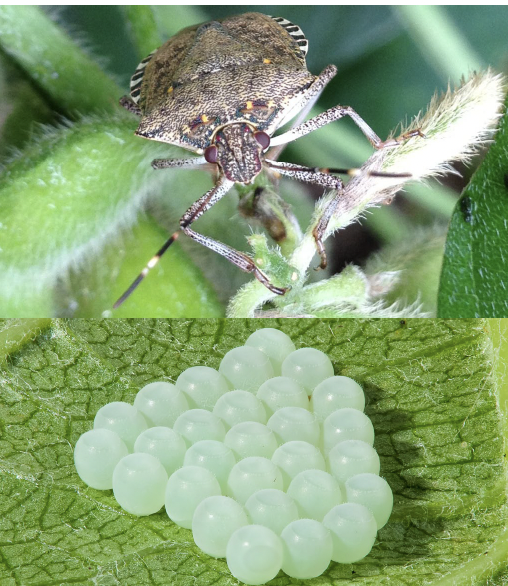
Biology and life cycle
There may be one or two generations per year in the mid-Atlantic U.S. BMSB overwinters as adults in protected spaces in natural areas or aggregates in large numbers inside hay bales, log piles, and man-made structures where they are often a nuisance. Overwintering adults emerge in late spring, mate, and begin laying eggs in early June.
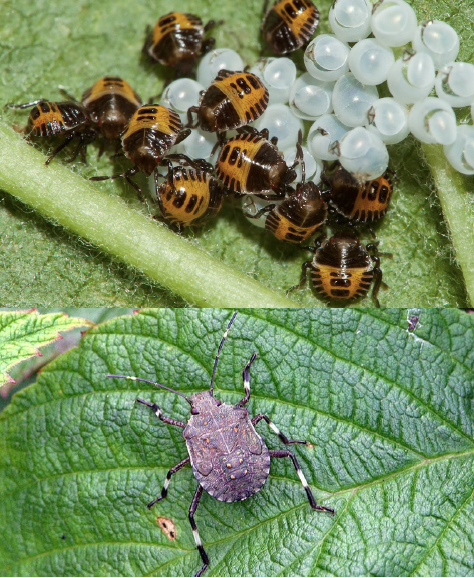
A single female can lay over 400 eggs. It takes approximately five days for eggs to hatch and three to eight days to develop through each of the five nymphal instars before molting into an adult. Under favorable conditions, egg to adult occurs in about 33 days. In the mid-Atlantic states, new adult abundance peaks between late July and early September. This is the generation that moves into soybean fields. Beginning in late September and throughout October, adults migrate from summer hosts, including soybean fields, back to overwintering sites.
Factors influencing population distribution
The distribution of BMSB throughout the mid-Atlantic is influenced by regional factors, while abundance of BMSB in soybean is influenced largely by local landscape. Temperature affects BMSB by directly influencing their development, survival, distributional range, and abundance. In soybean fields in the mid-Atlantic region, BMSB abundance increases as we move inland from the east coast. High temperatures (35ºC and above) during summer are lethal for developing eggs and early instars. This significantly regulates the overall population that develops into adults and later invades crops (Fig. 3).
Landscape factors that influence local abundance patterns of BMSB are proximity to developed areas and adjacent habitats comprised of suitable, alternate host plants. BMSB are “seed feeders” and efficiently move across host plants. Trees are the primary hosts for BMSB emerging from overwintering sites. Habitats adjacent to crop fields heavily impact BMSB density in soybean, but the influence of landscape factors on BMSB populations is localized.
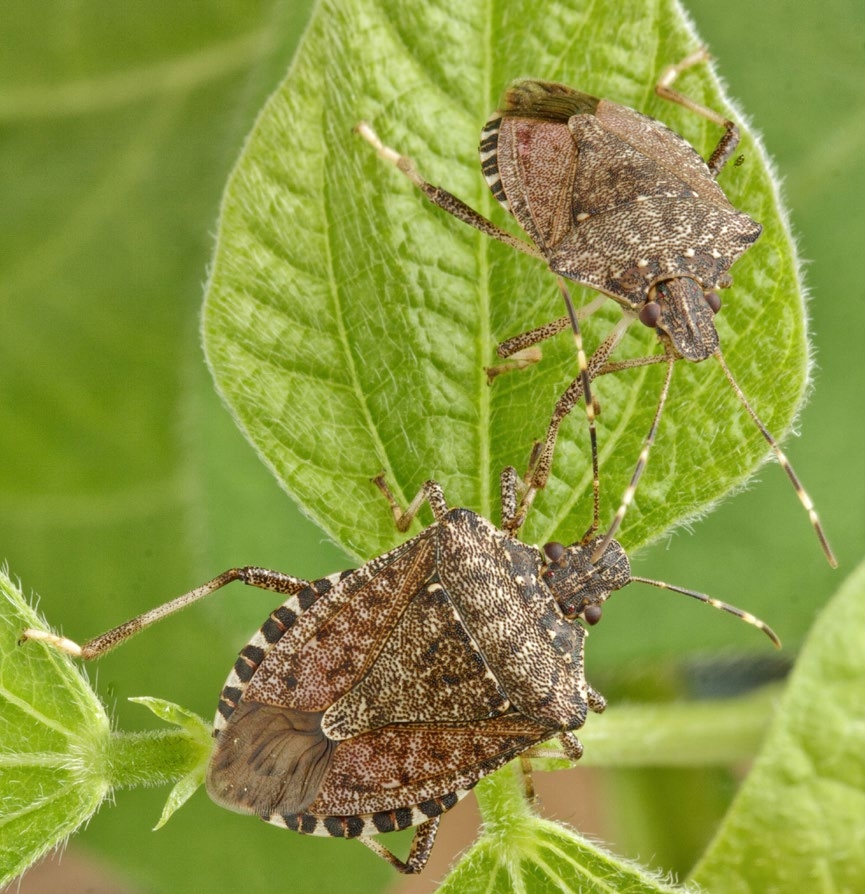
Field infestation patterns
BMSB infestations are greatest on field edges bordered by woods. BMSB do not move far from the invading field edge and do not disperse throughout the entire field (Fig. 4). BMSB populations quickly decrease beyond 50 ft from the field edge. Approximately half as many BMSB are detected at 50 ft into the field and very few BMSB are present 100 ft from field edge (Fig. 5).
This information can be used to focus scouting efforts. This also provides an opportunity to concentrate control efforts on field edges.
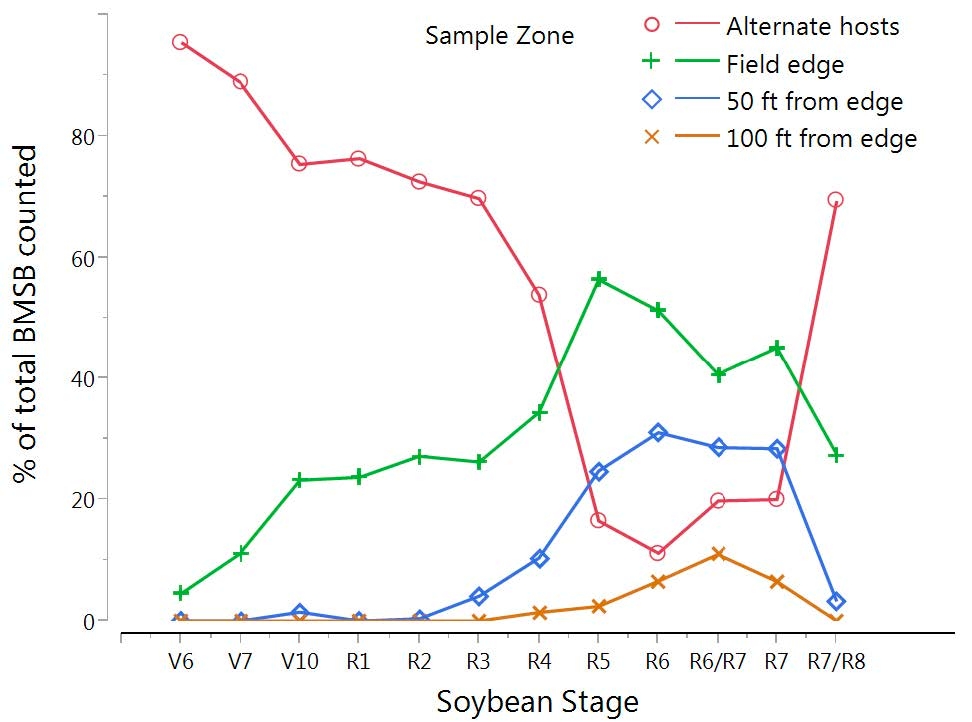

Crop injury
Brown marmorated stink bug adults and nymphs feed on soybean seeds. Like native stink bug species, they insert their piercing-sucking mouth parts, inject plant digestive enzymes, and extract the plant fluids. Feeding injury to seed in the early stages of pod development R3 (beginning pod) to R4 (full pod) can result in aborted pods or underdeveloped flat pods. Damaged pods are prematurely yellow with brown speckles where they have punctured the pod wall (Fig. 6).
Feeding injury to larger developing seeds, R5 (beginning seed) and R6 (full seed), results in shriveled, deformed, or even aborted seeds. Opening pods will reveal damage to the seed (Fig. 6).
BMSB feeding can cause delayed plant development referred to as “stay green” syndrome (Fig. 7). Soybeans will delay development to produce more seed to compensate for what may have been lost. As a result, portions of the field with heavy BMSB infestations remain green while the remainder of the field dries down. Stay green syndrome can result in yield loss because of the challenges associated with harvesting soybeans of different maturities.
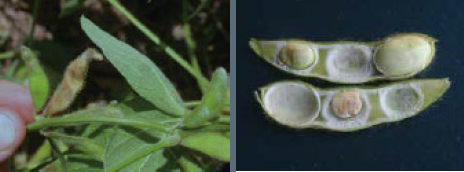
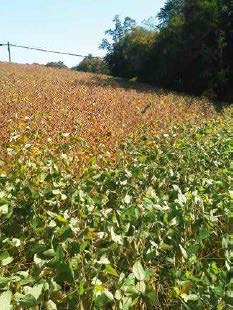
BMSB management in soybean
Field-edge only treatments
Over a 4-year period from 2011 – 2014, 35 commercial soybean fields with BMSB infestations at or above threshold on field edges were treated with a single insecticide application by making one sprayer pass around the field edge. Results showed that, in all but one case, treating field edges with a single, well-timed insecticide application (R4-R6) was successful in reducing populations below the threshold (Table 1). This treatment provided field-wide and season-long control.
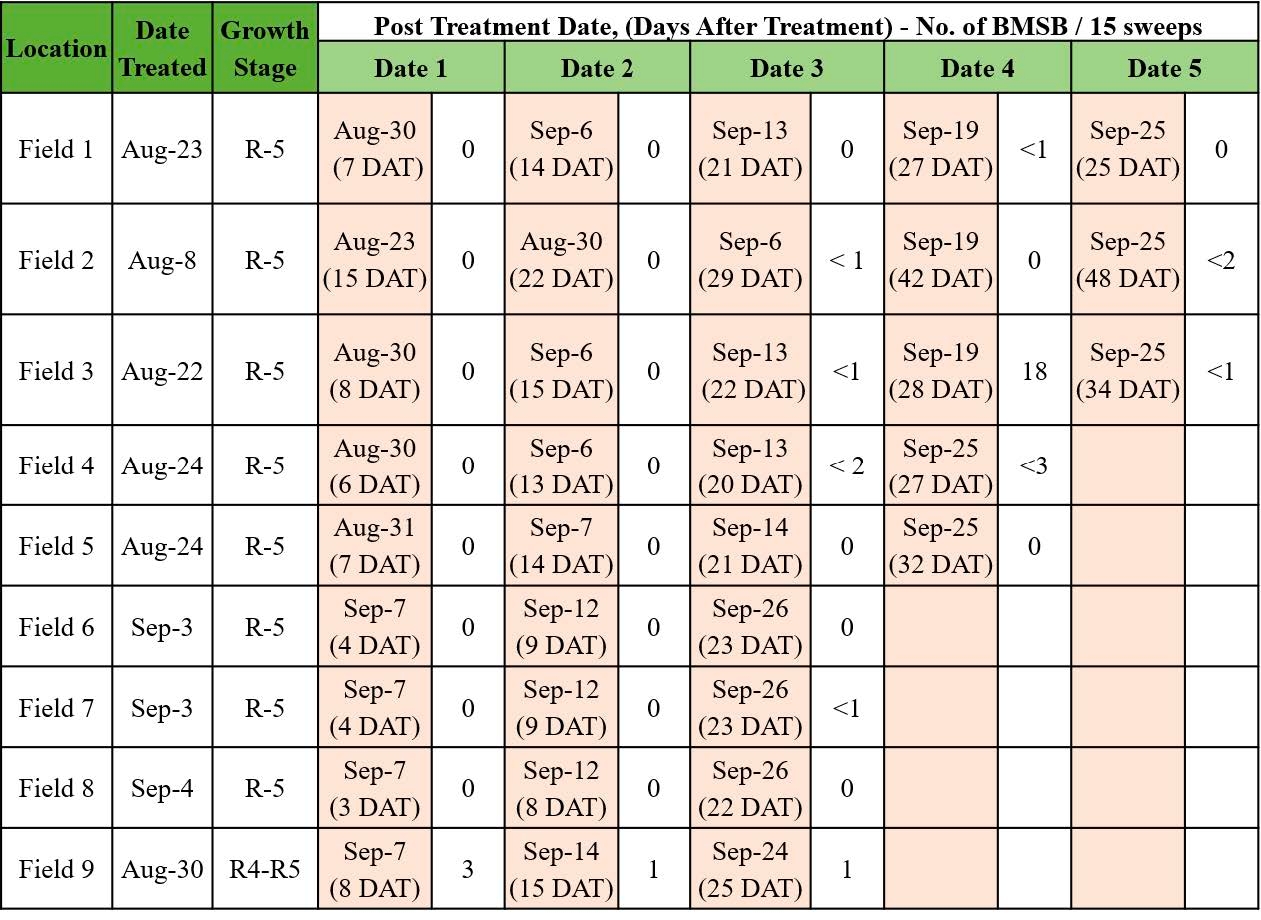
Thresholds and sampling
When to treat – The best time to treat is during the early R5 growth stage (seed development). Treat when stink bug densities are 0.5 per row foot, or when 3-5 stink bugs are caught per 15 sweeps, or 3-5 are observed in 2-minute visual counts per 10 feet.
Scouting – Begin scouting fields during the late R4 (pod elongation) and early R5 (seed development) growth stages. Focus your scouting efforts at field edges bordering woodlots and corn fields. Walk at least 10 feet into the field and take 3 separate sets of 15 sweeps or 2-minute counts at different parts of the field edge. Calculate the average number of stink bugs for 15 sweeps or 2-minute visual counts.
Where to treat – If needed, treat only the field edges, within 50 feet from the edge particularly along borders of woodlots. For sprayers with a 90-foot boom, and where field conditions are suitable, spraying with just one side of the boom (45 feet) along the edge will be sufficient to control stink bugs and prevent reinvasion.
Insecticide recommendations
Conventional Insecticides – Chemical classes including pyrethroids (beta-cyfluthrin, bifenthrin, lambda-cyhalothrin, zeta-cypermethrin), carbamates (methomyl), organophosphates (acephate), and neonicotinoid/pyrethroid mixtures (thiamethoxam + lambda-cyhalothrin, imidacloprid + beta-cyfluthrin) provide effective control of BMSB adults and nymphs.
Organic Insecticides – Insecticides providing up to 41% control of nymphs and adults included sabadilla and azadirachtin + pyrethrins, whereas pyrethrins resulted in the highest mortality with 80% control in laboratory experiments. In field trials, none of the treatments significantly suppressed BMSB except for one harvest date in 2014, when peppers treated with pyrethrins + azadirachtin had less injury than the control. These products can still be used together with cultural practices such as trap crops.
Biological control
Various natural enemies have been observed feeding on BMSB. Predators of BMSB (eggs and/or nymphs) include big eyed bugs, robber flies, minute pirate bugs, praying mantis, larvae of soft-winged flower beetles, assassin bugs, and various spiders. Mortality of BMSB eggs due to predation and other causes reached 40-70% in soybean. Though parasitoid wasps are known to use BMSB eggs as host for depositing their eggs, rates of parasitism of BMSB eggs are generally low (< 5%).
BMSB damage in edamame
Edamame, or vegetable soybean, is gaining popularity. Edamame is very similar to soybeans except that it is harvested at R6 and consumed. The largest threat to mid-Atlantic edamame is stink bugs based on current knowledge. BMSB causes cosmetic injury to the edamame making them unmarketable (Fig. 8). The damage can be quite severe, and in some cases upwards of 40% of pods are unmarketable at harvest. It is crucial to control for BMSB and other stink bugs from R3 until harvest.
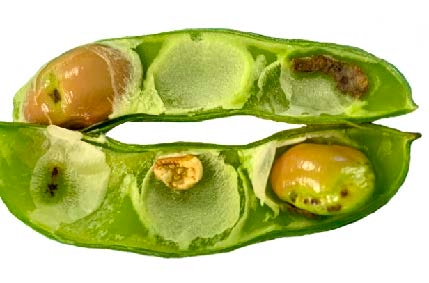
Summary
- BMSB feed on developing pods and seed resulting in quality and yield reductions.
- Under heavy infestations, BMSB feeding injury can result in “stay green” syndrome.
- Soybean fields in proximity to developed areas and those bordered by woods are at greatest risk for BMSB infestations.
- BMSB are not usually distributed evenly throughout soybean fields and are typically concentrated on field edges, rarely reaching economic thresholds within field middles.
- A single well-timed field-edge only treatment can be successful in reducing BMSB populations below the economic threshold.
- Scouting efforts should begin during the late R4 (pod elongation) to early R5 (seed development) growth stages.
- The best time to make an insecticide application is during the early R5 growth stage to prevent seed quality and yield losses.
- The recommended threshold is 0.5 BMSB per linear ft of row or 3-5 BMSB per 15 sweeps or 3-5 BMSB per 2-minute visual count.
- Control can be achieved with products in the following chemical classes: pyrethroid, carbamate, organophosphate, and neonicotinoid/pyrethroid mixtures.
- Organic insecticides such as spinosad + potassium salts of fatty acids, azadirachtin + pyrethrins + potassium salts of fatty acids, spinosad, and azadirachtin are effective against BMSB nymphs but not adults.
- Various natural enemies have been observed feeding on BMSB in soybean including predators and egg parasitoids.
References
Aigner, B. L., T. P. Kuhar, D. A. Herbert, C. C. Brewster, J.W. Hogue, and J. D. Aigner. 2017. “Brown Marmorated Stink Bug (Hemiptera: Pentatomidae) Infestations in Tree Borders and Subsequent Patterns of Abundance in Soybean Fields”. Journal of Economic Entomology, 110(2), 487–490. https://academic.oup.com/jee/article/110/2/487/3061481?login=true
Alford, A., T. P. Kuhar, G. C. Hamilton, P. Jentsch, G. Krawczyk, J. F. Walgenbach, and C. Welty. 2020. “Baseline Toxicity of the Insecticides Bifenthrin and Thiamethoxam on Halyomorpha halys (Hemiptera: Pentatomidae) Collected from the Eastern United States”. Journal of Economic Entomology, 113(2), 1043–1046. https://academic.oup.com/jee/article/113/2/1043/5697180?login=true
Hoebeke, E. R. and M. E. Carter. 2003. “Halyomorpha halys (Stal) (Heteroptera: Pentatomidae): A polyphagous plant pest from Asia newly detected in North America”. Proceedings of the Entomological Society of Washington 105: 225–237. https://www.cabi.org/isc/abstract/20033040299
Valentin, R. E., D. M. Fonseca, A. L. Nielsen, T. C. Leskey, and J. L. Lockwood. 2018. “Early detection of invasive exotic insect infestations using eDNA from crop surfaces”. Frontiers in Ecology and the Environment; 16(5): 265–270. https://esajournals.onlinelibrary.wiley.com/doi/abs/10.1002/fee.1811
Virginia Cooperative Extension materials are available for public use, reprint, or citation without further permission, provided the use includes credit to the author and to Virginia Cooperative Extension, Virginia Tech, and Virginia State University.
Virginia Cooperative Extension is a partnership of Virginia Tech, Virginia State University, the U.S. Department of Agriculture, and local governments. Its programs and employment are open to all, regardless of age, color, disability, sex (including pregnancy), gender, gender identity, gender expression, genetic information, ethnicity or national origin, political affiliation, race, religion, sexual orientation, or military status, or any other basis protected by law.
Publication Date
July 2, 2021



